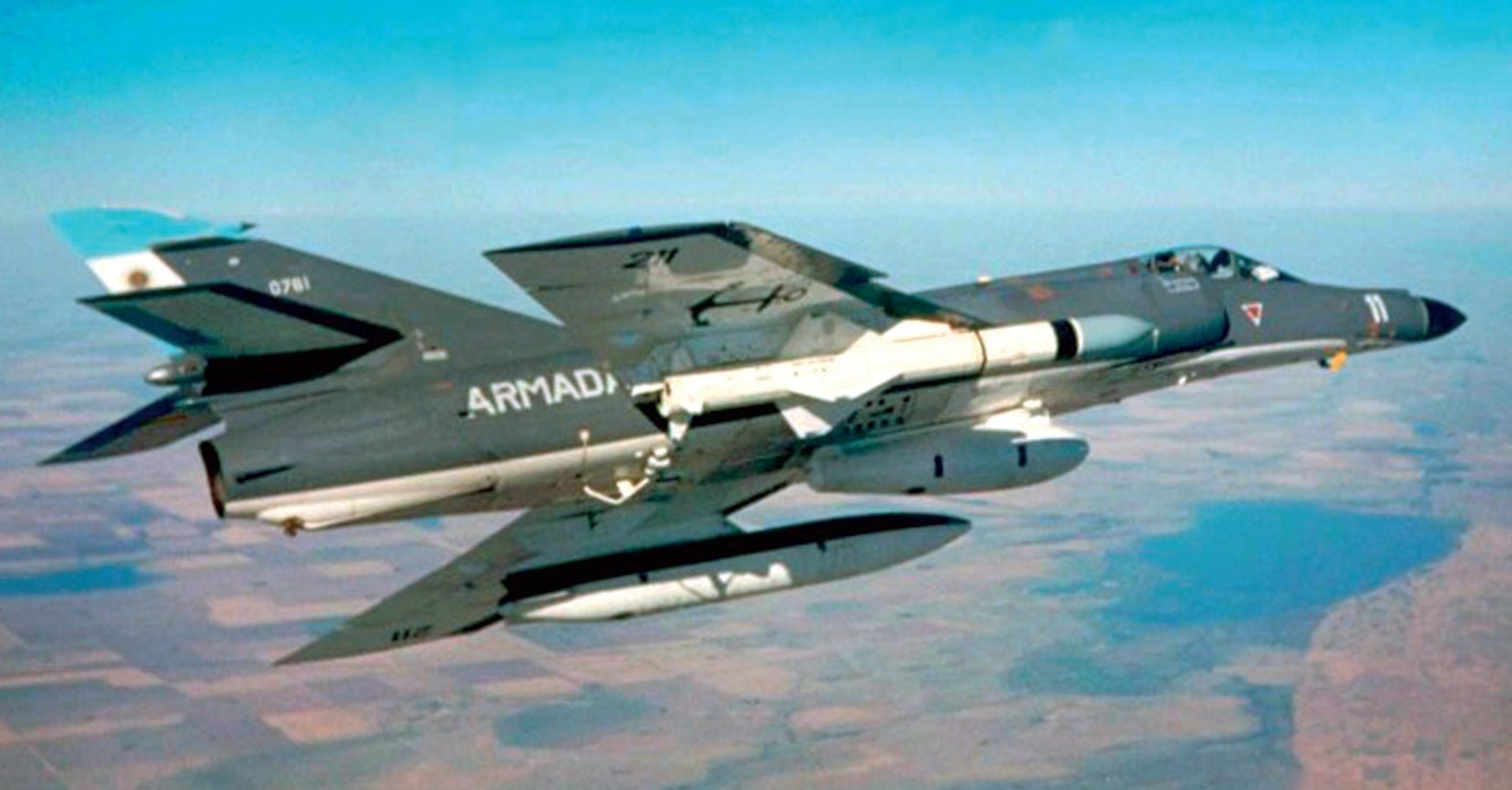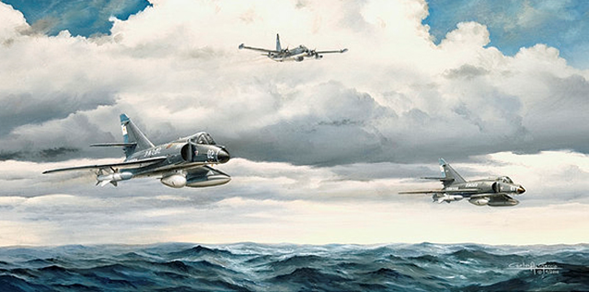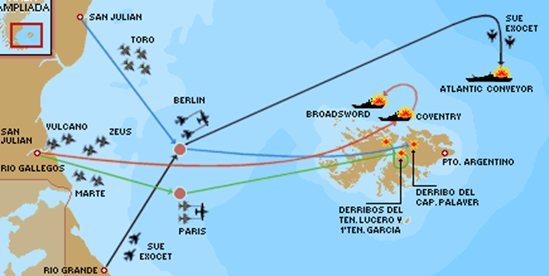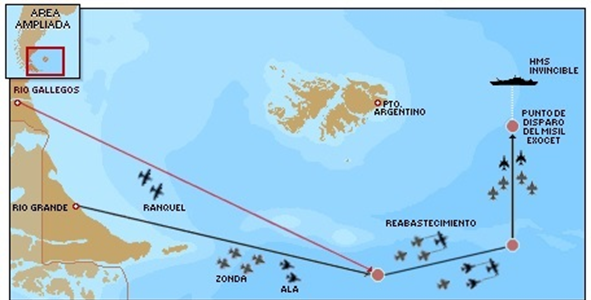

By WIDOW RUIZ, JUAN A. .
En la guerra de las Malvinas fue la primera vez que se usaron en combate los misiles aire-superficie. El hundimiento de dos buques ingleses significó fama mundial para el avión Super Etendard y el Exocet AM-39. Dos misiles fueron lanzados en cada ataque, pero Argentina poseía cinco. Los relatos de ambos países coinciden en que el último se utilizó para intentar atacar al portaaviones HMS Invincible. Se exponen los antecedentes y el desarrollo del ataque al portaaviones, contrastando ambas versiones sobre el éxito de la misión.
During the Falklands-Malvinas conflict, for the first time airborne anti-ship missiles were used in combat. The sinking of two British ships brought worldwide reputation to the Super Etendard fighter and the Exocet AM-39 missile. Two missiles were fired during each attack, but Argentina had a total of five missiles. Both countries’ accounts concur that the last one was used attempting to hit the British aircraft carrier HMS Invincible. The background and development of the attack on the carrier are discussed, comparing both versions of the success of that mission.

On April 2nd, 1982, the capture of the Falkland-Malvinas Islands, and the islands of South Georgia marked the beginning of the conflict between Argentina and the United Kingdom over the sovereignty of those islands. Britain reacted to this invasion by deploying a task force led by the aircraft carriers HMS Hermes and HMS Invincible.
Months before the war, the Argentine Navy had started receiving the first batch of a total of fourteen French naval Super Etendard carrier-borne strike fighter. This acquisition was made to replace the aging A-4Q Skyhawk navy jets that conformed the air-wing of the aircraft carrier 25 de Mayo. These aircraft were equipped with the AM-39 missile, an airborne version of the Exocet anti-ship missile, which both navies had onboard their surface combatants at the time of this conflict. However, at the beginning of the war, France embargoed the Argentine purchases, so only five aircraft and five missiles were received. Furthermore, the 25 de Mayo did not receive in due time the modifications required to operate the Super Etendard onboard her deck. Due to this circumstance, these five navy fighters had to operate from “Río Grande” Naval Air Station, in Tierra del Fuego.
Apart from this, the French manufacture had not yet completed the electronic interconnections of the missile to the aircraft. In his interview with Gallardo (2017), Lieutenant Commander Roberto Curilovic recalls that this technical problem was skillfully solved by naval technicians, who relied on information obtained by the officers stationed in France during the construction of these planes. In the same interview, Curilovic explains that, although the aircraft could operate with other types of weaponry, the crew of the newly formed squadron decided instead to take advantage of the capabilities of this new missile. They began developing new tactics that would enable them to exploit the missile´s potential. For this task, they trained using as targets the argentine navy´s two type 42 destroyers, which, as with their Royal Navy´s counterparts, were fitted with the same Sea-Dart area-defense missile system. The Argentine pilots opted for low-level penetration tactics, which meant flying in total electronic silence and climbing (pop-up) just before each attack, at which moment they switched their on-board radars to confirm and designate the targets. This tactic maximized the surprise factor.
Maritime patrolling (scouting) was executed primarily by two navy P-2 Neptune Maritime Patrol Aircraft (MPA), whose sensors (basically radar) enabled them to, in advance, locate enemy targets, but not adequately identify them. The P-2´s restrictions limited the fighter´s accuracy in target assignment, which, considering the limited missiles available, had to be targeted on high-value-units (HVU). Furthermore, target damage-assessment after each attack was almost impossible.
On May 4th, 1982, at 07:50 hours, one of the Neptune MPA acquired a surface radar contact approximately 85 nautical miles south of Port Stanley (Puerto Argentino). At 08:45 the Neptune gained two more contacts, two medium and one large. With this information, two Super Etendard, on high alert were ordered to take-off. The navy pilots, Commander Augusto Bedacarratz and Lieutenant Armando Mayora, refueled from a tanker soon after take-off, and on their transit, the Neptune updated the targets’ location at 115 nm east of the Etendard´s position, after which the Neptune returned to its home base. The strike jets, flying at sea level, continued on their own. On the second climb (or pop-up), their radars gained contact, designated a target, and fired their missiles, taking evasive maneuvers after firing their weapons. The distance at which they fired their missiles is disputed, varying between 27 and 9.1 miles from the target.

The ships detected by the argentine fighters were three Type 42 destroyers, on AAW radar picket duty, spread 15 miles apart, covering the threat axis. The three destroyers were positioned 18 nautical miles west of the British carriers. HMS Glasgow, stationed at the center of the formation, was the first ship in detecting the Super Etendards 40 miles west of their position. Contact was made initially made by her Electronic Support Measures (ESM) and soon after by her AAW air search radar. Glasgow immediately sounded General quarters and reported this information to the Task force. However, the Anti-Aircraft Warfare Commander (AAWC), onboard Invincible, disregarded this warning.
HMS Sheffield, the southernmost unit of this formation, had downgraded this alert. Sheffield thought an attack of this type was unlikely, estimating the fighter´s Exocet missile system was not yet been integrated to the planes. Contributing to this lack of alertness, was recurrent false alarms from her ESM, identifying the electronic signals as Etendard's radars. In addition, the ship at the time of the attack, was using her satellite communications system which interfered with her ESM. Furthermore, Sheffield´s Anti-Air Warfare Officer (AAWO) at that moment was outside the Operation Room when HMS Glasgow flashed the air-raid warning. In fact, Glasgow was the ship targeted by the Argentine pilots, but she managed to evade the incoming missiles by promptly deploying chaff decoy. One of the two missiles impacted Sheffield and although it is believed that it did not explode, caused a fire of such magnitude that four hours later the ship had to be abandoned. This attack neutralized a third of the British anti-aircraft area defense, which, at that time had only three AAW destroyers in the theater of operations. This information was unknown by the Argentinians until that day, when the British media broadcasted the attack on radio and television, disclosing this vital intelligence to the world, and the enemy.
Shortly after the attack on Sheffield, both P-2 Neptune became inoperative. Maritime scouting was then assigned to aircrafts with less range and endurance, fitted only with weather radars, which meant a loss of capability in detecting and designating enemy targets. To compensate this deficiency, operators of the anti-aircraft radars stationed in Port Stanley-Puerto Argentino tracked the Sea Harriers from when first detected until they lost contact, thus triangulating, quite accurately, the location of the British carriers, at approximately 100 miles Northeast of the Falkland. Using this information, on the May 25th, the Argentinian naval command planned a strike on the British carriers, employing two Super Etendard, each carrying an Exocet missile. On this occasion the attack was performed by Lieutenant Commander Roberto Curilovic and Lieutenant Julio Barraza.
Since the British by then knew that the Super Etendard-Exocet system was operational and that these aircrafts were deployed in Rio Grande Naval Air Station, the argentine naval command planned a deceptive maneuver. The strike followed a different direction of approach, with the fighters flying the first leg on a northeasterly course, refueling 160 miles east of Puerto Deseado, then approaching from the northeast of the British task force, away from the expected thread axis. On their second pop-up, the pilots detected two medium and one small target, designated their missiles, and at a range of 25 miles, released their weapons of the larger target, then taking an evasive course towards Puerto Deseado. The refueling aircraft had remained on-station, and after four hours of flight and having flown 1,700 miles, the fighters returned directly to their home base in Rio Grande.

Brown (1989), states that the ships detected by the Argentinian pilots were the frigate HMS Ambuscade, the amphibious ship RFA Sir Tristram and M/V Atlantic Conveyor, while Woodward (1992) states that the planes fired on the first radar contact, which corresponded to Ambuscade. On this opportunity, the British ships reacted correctly, promptly executing their pre-planned evasive actions, so the missiles hurtle through the chaff cloud deployed by Ambuscade, locking instead on Atlantic Conveyor which did not have these types of countermeasures. Dr. Gordon Brooks, the medical officer aboard on the Atlantic Conveyor; however, noting the numerous contradictions in official sources, and with new facts available, in 2013 published his investigation of this attack. He concludes that both missiles were designated on HMS Hermes, which was sailing in line-abreast with Atlantic Conveyor and since HMS Ambuscade was in the missile´s line of fire, they had flown along her beam, on their way to the flagship. Atlantic Conveyor didn´t know the incoming missiles´ direction of approach. The recommended anti-missile evasive maneuver for that type of ship, was to present her stern towards the threat, however she was ordered to alter course to 040°, therefore presenting her beam, consequently maximizing her radar cross-section. HMS Hermes turned in the opposite direction, presenting her bow into the incoming missiles, reversing her relative position with Atlantic Conveyor, which probably lured the missiles towards her, eventually taking the hits. At the time of the attack, RFA Sir Tristram was not in the proximities, and both Brown and Woodward omit in their books the presence of Hermes in the vicinity of the stricken merchant. Although all fourteen Harriers had already flown off Atlantic Conveyor´s deck, onboard still remained eight helicopters, plus aviation spares, ammunition, a modular airstrip, and logistical support for a 4,500 men brigade. The ship was schedule to disembark this precious cargo on San Carlos later that night, but all was lost. Due to the cargo´s value, the Atlantic Conveyor had been deliberately stationed at the center of the formation, being the ship farthest from the expected axis of attack of the missile fighters (Woodward, 1992).
Probably, the loss of Atlantic Conveyor was the most serious suffered by the British during this conflict. But, analyzing the relative positions during this attack, it can be affirmed that this huge merchant ship saved HMS Hermes from being hit. After the war Admiral Woodward pointed out that the loss of a carrier would have forced the withdrawal of the Task Force from the Theater of operations. Atlantic Conveyor went down on the 28th of May, three days after the attack.
British and Argentine versions of this attack, coincides in the distance at which the missiles were fired. Regarding battle-damage assessment, once more this was provided to the Argentinians by the British media. That same night BBC transmitted the news of the attack and their casualties. (Gallardo, 2017).
By the end of May the conflict was reaching its final phase, the British had secured a beachhead at San Carlos bay, and the Argentinian radar operators had updated the location of the British carriers. The last strike with the remaining Exocet missile was schedule for May 30th. The target was located by radar-fix at 100 miles southeast of Port Stanley (Puerto Argentino). The attack was led by two Super Etendard, together with four Air Force A-4C. Navy pilots Lieutenant Commander Alejandro Francisco, and Lieutenant Luis Collavino, flew the Super Etendards carrying the last Exocet. Both Etendards would guide the four non-radar-equipped A-4Cs piloted by Air Force lieutenants José Vásquez, Ernesto Ureta, Omar Castillo, and sub-lieutenant Gerardo Isaac.
On this occasion it was decided to penetrate enemy airspace from the south. The planes took off from Rio Grande on a southeasterly course, flying to a position 200 miles south of the islands, where they made the refueling rendezvous, while transiting on an easterly course. They finally turned north and began their approach on a heading of 345° towards the British Battle Group. At 55 miles from the target´s estimated position, they climbed for a first pop-up and one of the navy fighters acquired a large and a medium radar contact, 10-5 miles further east of the triangulated location estimated by the argentine´s radar operator. At 40 and then 25 miles out, they repeated this maneuver, both aircraft detecting the same targets. At approximately 20 miles, Lieutenant Commander Francisco fired the last missile, relaying the target´s location to the four A-4Cs, which followed the wake of the missile as it flew towards its target. Meanwhile the Super Etendard took evasive maneuvers. Shortly thereafter, in the bearing in which they had lost sight of the missile, the Skyhawks pilots sighted a large, “asymmetrical” ship, which they identified as an aircraft carrier, from which two plumes of smoke were beginning to billow from the ship´s side.
At about seven miles from the target lieutenant Vásquez´s plane was hit, and further on, around 2,000 yds, lieutenant Castillo was shot down. According to lieutenant Ureta´s statement in the interview published by the Argentine Air Force in 2019, he climbed to drop his bombs, being able to appreciate that his weapons hit the carrier´s flight deck, while sub-lieutenant Isaac, flying lower than the carrier´s main deck, dropped his bombs and had to make a hard right turn to avoid hitting the ship. Sub-lieutenant Isaac claims to have seen the target engulfed in smoke while performing evasive maneuvers (Carballo, 1983). The Argentine fighters refueled again on their way back. Upon arriving at Rio Grande Naval base, they separately submitted their post-flight intelligence debrief, both assure hitting Invincible´s quarter.

Brown (1989) states that the raid was detected by HMS Exeter, a Type 42 destroyer on picket duty west of the task force, as the Super Etendards popped-up, 32 miles out. According to him, the Exocet was launched on a false echo between Exeter and HMS Avenger, a Type 21 frigate, which, according to Woodward (1992), was 12 miles south-southeast of Exeter. The first Skyhawk allegedly was shot down by HMS Exeter´s Sea Dart missiles, and the second A-4C was hit by another Sea Dart, or by Avenger´s guns, when the plane flew over her. The remaining two planes supposedly attacked the frigate, nor the carrier, mistaking the smoke from her turbines (Brown, 1989) or Avenger´s 4.5” gun (Woodward, 1992) which would have caused the missile´s explosion. Woodward says that HMS Invincible was 20 miles east of them, although other sources concur that the carrier was 10 miles east of Exeter, and 17 miles northeast of Ambuscade.
At the end of the war, HMS Invincible sailed 3,000 miles northeast of the Falkland, were she replaced one of her turbines, a feast never performed at sea (Brown, 1989). Subsequently Invincible returned to the Falkland to performed air-defense duties until relieved by her sister ship HMS Illustrious, returning to her homeport in Portsmouth, in September of 1982.
Numerous versions and even conspiracy theories have emerged regarding what really happened that day. Different versions range from; the carrier not being hit at all, her being sunk and secretly replaced, to the possibility that the missile struck the hull of Atlantic Conveyor, which in fact had sunk two days earlier.
Taken separately, the Argentine and British versions of May 30´s attack end up in a difficult “your-word against-mine”. Taken together, there´s so many contradictions that it seems impossible to arrive to the truth of the matter. However, some of these contradictions are possible to contrast and analyze, adding new information that has come up over the years:
Considering the above, it seems possible that Invincible was indeed attacked, although not hit or at least not severely damaged. The evidence, however, is circumstantial and controversial, and there is still no clarity as to what really happened that day. Each reader, based on what has been written and on what he or she is able to investigate, will have to form their own opinion, at least until new information becomes available. For now, this event remains in uncertainty.
&&&&&&&&&&
El 2 de abril de 1982, fuerzas argentinas invaden las islas Falkland/Malvinas con 900 hombres, entre infantes de marina ...
¿Era posible robar un sonar remolcado en plena navegación? ¿Eran capaces los argentinos de hundir un buque inglés en Gib...
Versión PDF
Año CXXXX, Volumen 143, Número 1008
Septiembre - Octubre 2025
Inicie sesión con su cuenta de suscriptor para comentar.-